Want to get in front of your competitors’ customers on Facebook? Wondering what types of Facebook ad targeting your competitors are using?
In this article, you’ll learn how to research and model Facebook audience targeting used by your competitors.
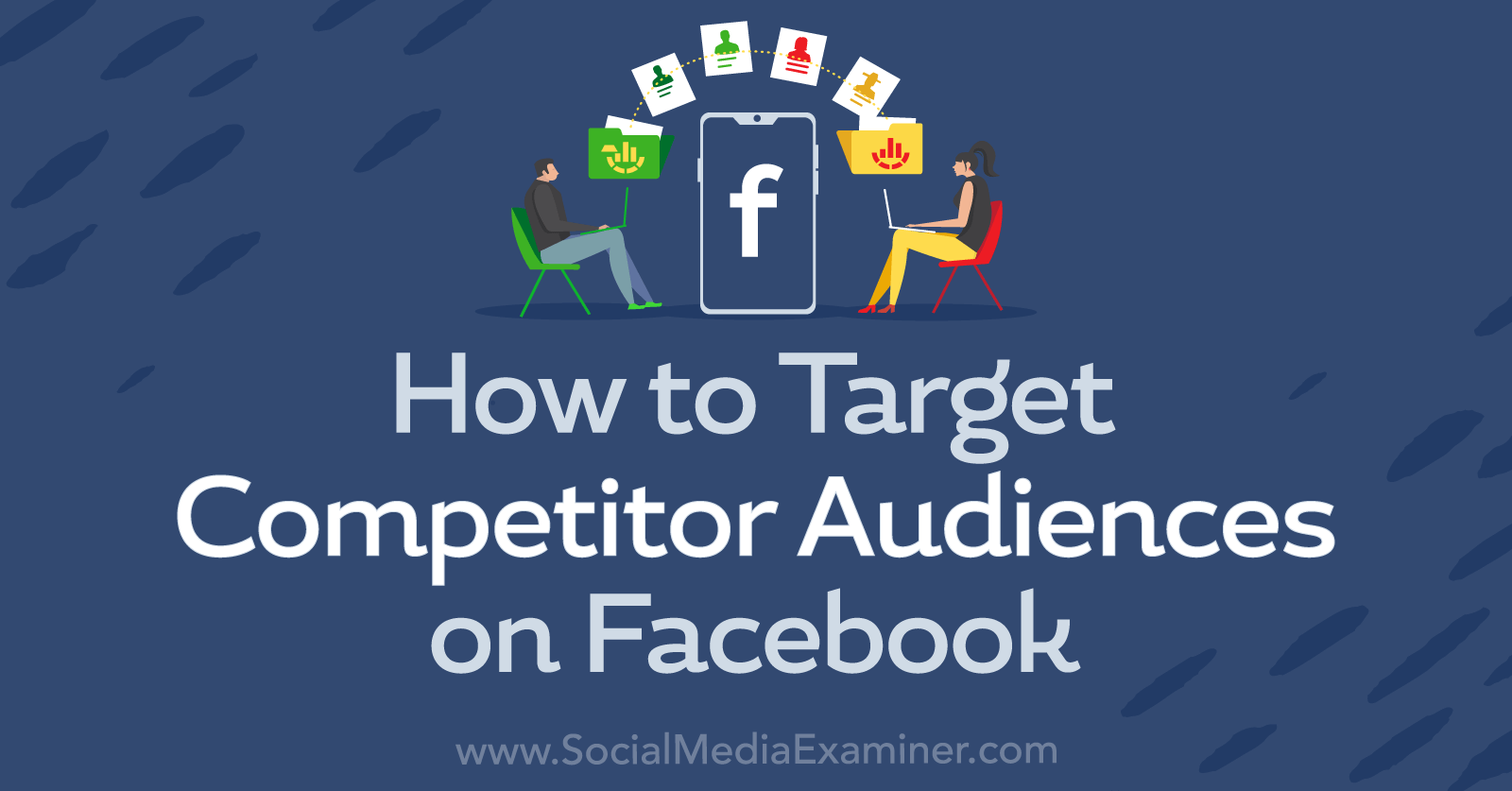
How to Research Competitor Audiences on Facebook
Who are your competitors targeting, anyway? Before you can get your content in front of them, some research is in order. Let’s look at options for researching organic and paid audiences using native Facebook tools.
#1: How to Find Competitors’ Organic Audiences on Facebook
Whether you already have a list of competitors in mind or you need a little inspiration, Facebook’s native tools can guide your organic audience research.
Get Ideas From Business Suite Benchmarking
You probably already use Business Suite insights to track performance metrics for your page but this tool is just as helpful for competitive research. To get started, open Business Suite and navigate to your page’s insights.
Then open the Benchmarking tab. If you’ve used Facebook’s Pages to Watch feature in the past, this interface might look familiar. Both tools allow you to benchmark your page’s performance against competitors.

But unlike the Pages to Watch feature, Benchmarking doesn’t require you to come up with a competitor list independently. Instead, it recommends pages that are similar to your company page, which is helpful if you’re not sure where to start or if you need new ideas.
Once you click to add a business to your list, you can see how your page’s performance compares over time. You can also click to go right to your competitors’ Facebook pages, where you can do additional research (see below).
Check Business Suite Audience Insights
For even more ideas, go to the Audience tab in Business Suite insights. Instead of reviewing your current audience, click on Potential Audience. Then open the filter in the upper-right corner and enter some of the characteristics of your audience.
For example, start by entering demographic details like age, gender, and location. Then add some of the main interests your audience has in common.
As you define your target audience, you’ll see the estimated size and demographic breakdown adjust automatically. You can absolutely use these demographics—age, gender, and location—to refine your organic strategy or build your paid audience.
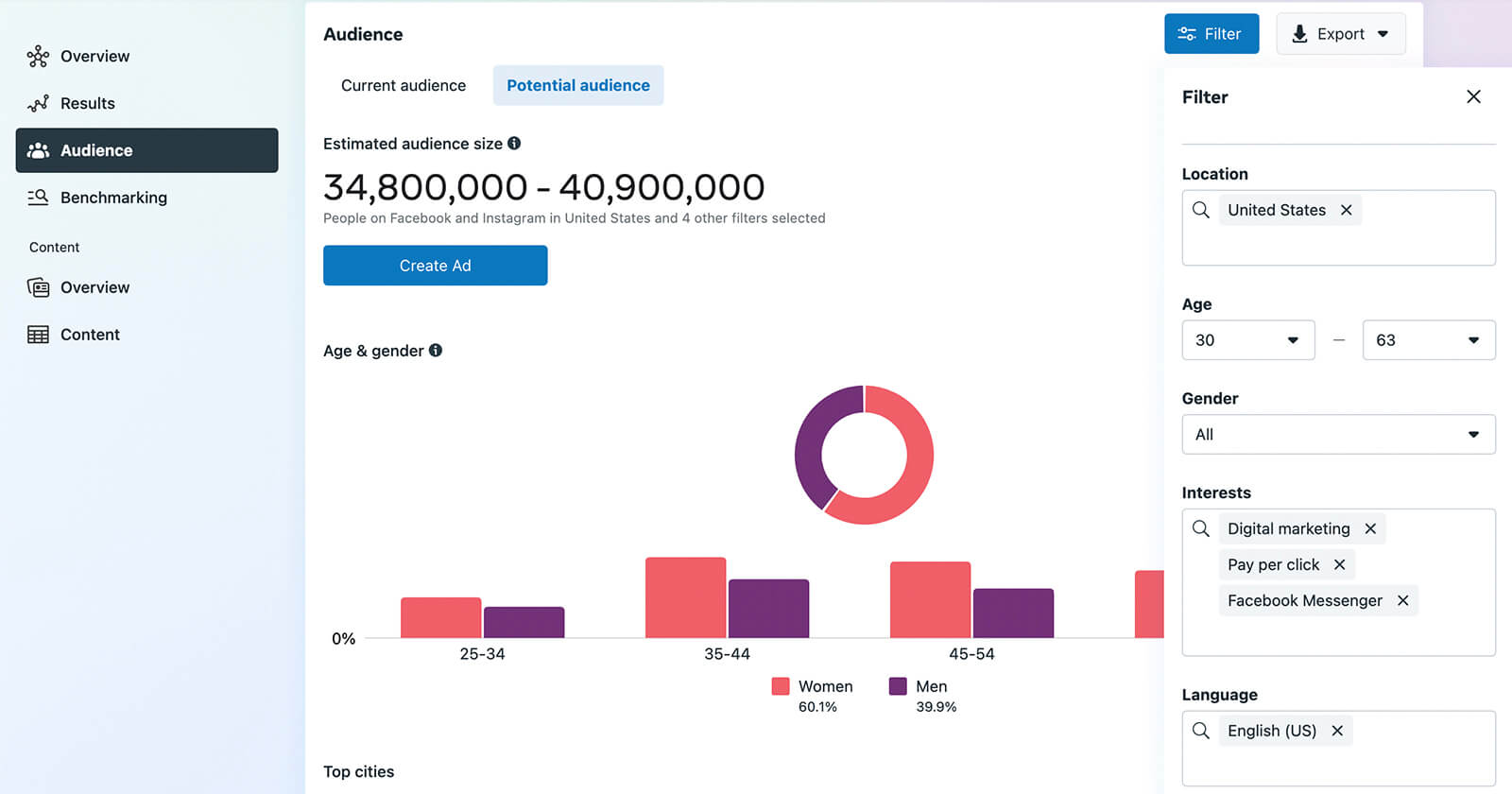
But it’s also helpful to review the top pages related to the audience you’ve built. Scroll down to see the top-ranked pages in categories like media, retail, and public figures. Some of these pages may be direct competitors, while others may be worth adding as interests to your paid audiences.

#2: How to Analyze Competitors’ Facebook Pages
Next, gather your competitor list and ideas from the steps above. Find each competitor on Facebook and like or follow its page. If you’re lucky, you’ll find some interesting ideas in the Related Pages list that automatically pops up after you like a page.
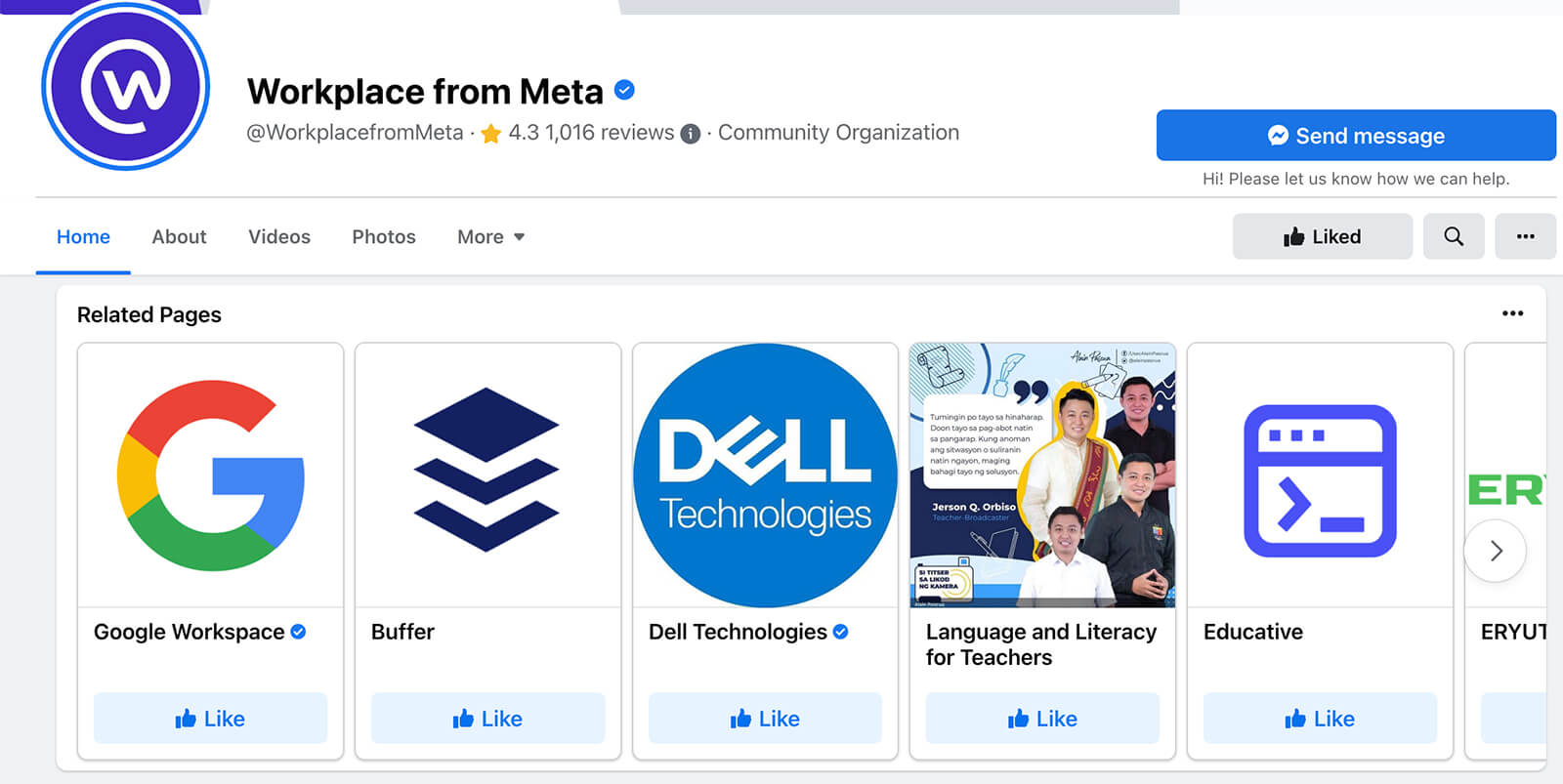
Click to view the follow settings for each page. For quick access, add them to your Favorites list so you can easily refer to them in Facebook’s new custom feed.
Get World-Class Marketing Training — All Year Long!
Are you facing doubt, uncertainty, or overwhelm? The Social Media Marketing Society can help.
Each month, you’ll receive training from trusted marketing experts, covering everything from AI to organic social marketing. When you join, you’ll also get immediate access to:
- A library of 100+ marketing trainings
- A community of like-minded marketers
- Monthly online community meetups
- Relevant news and trends updates
Then spend some time getting to know their Facebook audiences. Do some followers comment on or engage with virtually every post? Those who have a blue check or a Follow button next to their name may be influencers or thought leaders, and may be worth following as well.
To identify other influential people in your competitors’ audiences, look for followers who have badges. For example, the Top Fans badge denotes people who are particularly engaged, while the Anniversary Follower badge highlights people who have followed the page for at least a year.
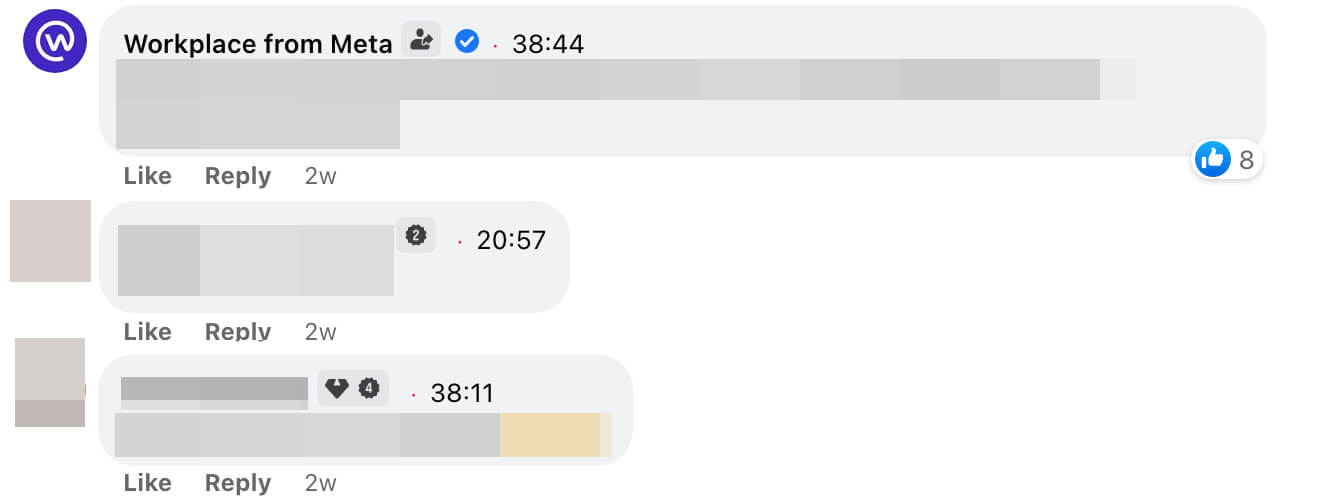
If the influencers have public profiles or linked pages, you can use them to learn even more about your competitors’ audiences. You may be able to target larger influencers with Facebook’s interest targeting. At the very least, you can browse their content to identify additional topics that you can use to create Facebook custom audiences that will reach your competitor's customer base.
#3: How to Find Competitors’ Paid Audiences on Facebook
Next, spend some time digging into your competitors’ Facebook ads and audience targeting parameters.
Review Facebook Ads In Your Profile's Feed
If you follow your competitors’ Facebook pages, visit their websites, and engage with related content, you may see their ads in your feed. As long as you give Facebook these signals, you should see ads that are relevant to your industry, even if you don’t necessarily see direct competitors’ ads.
When you see paid content from a competitor or another business in your industry, click the three dots in the upper-right corner of the ad. From the drop-down menu, select Why Am I Seeing This Ad?
Then review the reasons to learn more about the audience targeting. For example, you may spot demographic targeting like age, language, and location parameters.
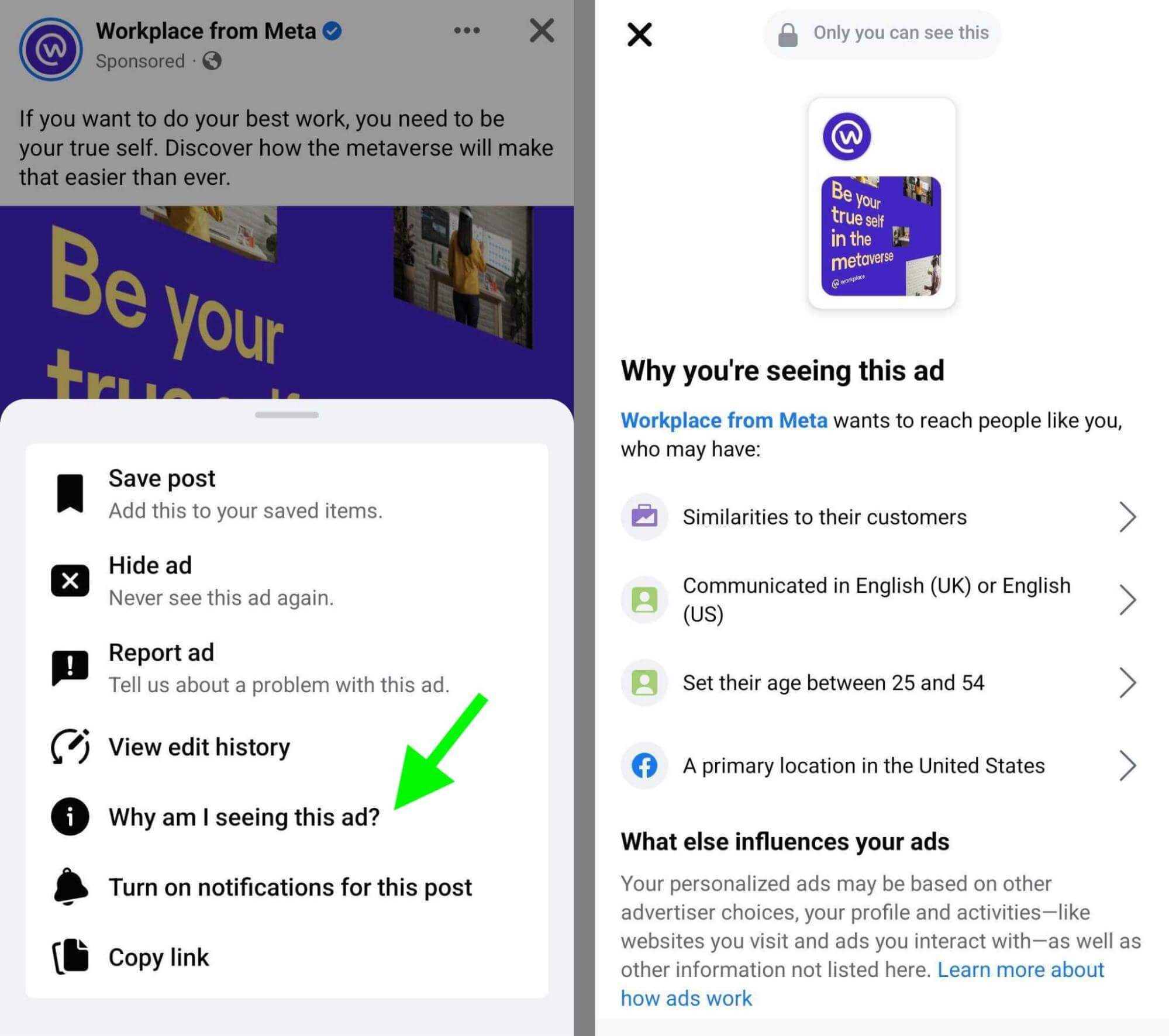
Or you might spot interest-based targeting. Make note of these interests so you can consider adding them to your paid audiences. You can always use Facebook Audience Manager to keep a running list of potential interests and gauge the size of the audience they’d reach.
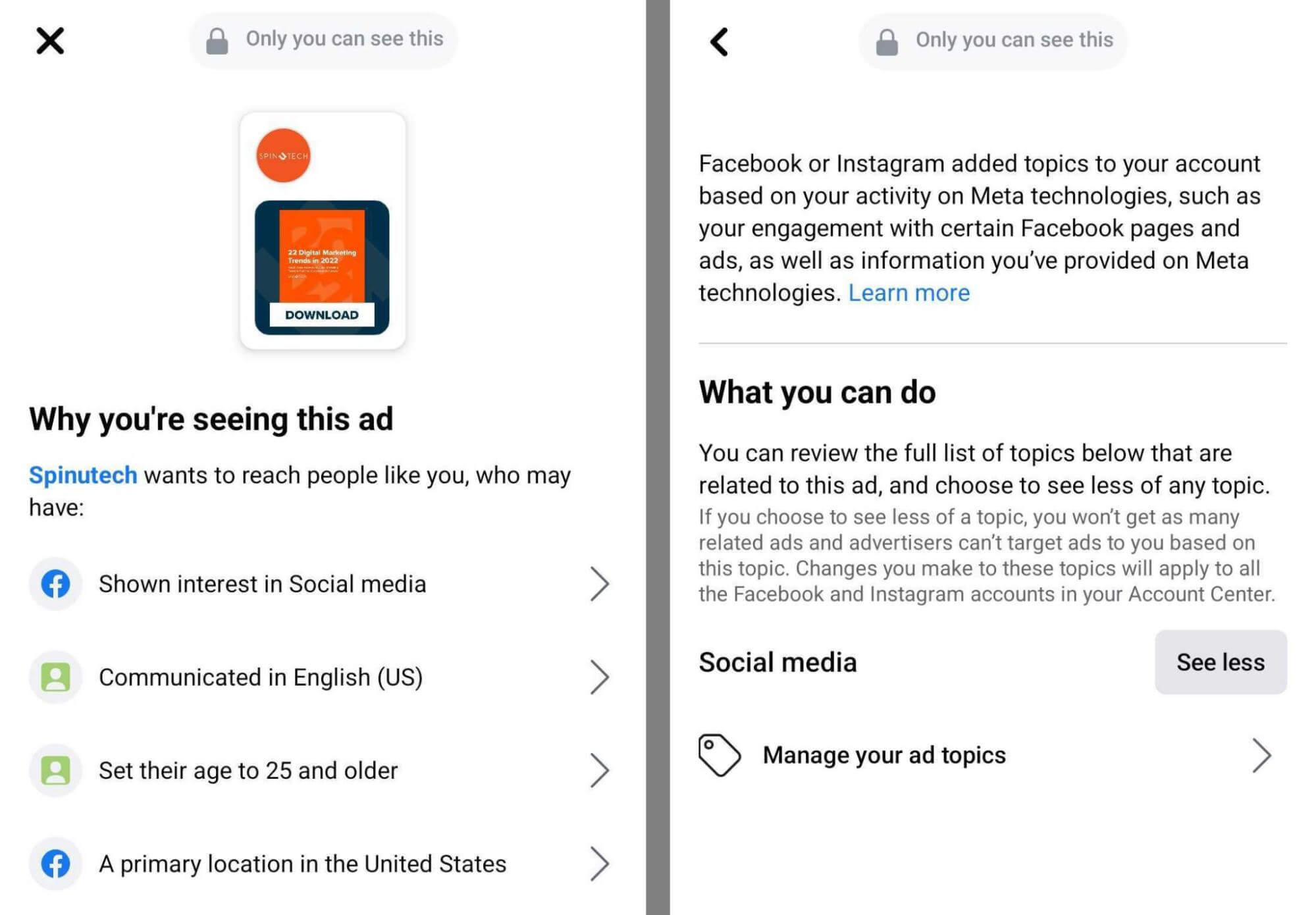
You might also notice that you’re seeing ads because of similarities to their customers. Although you can’t see why you’re similar to their customers, this targeting may inspire you to create Facebook lookalike audiences for your best-performing paid audiences. We’ll walk through that process below.
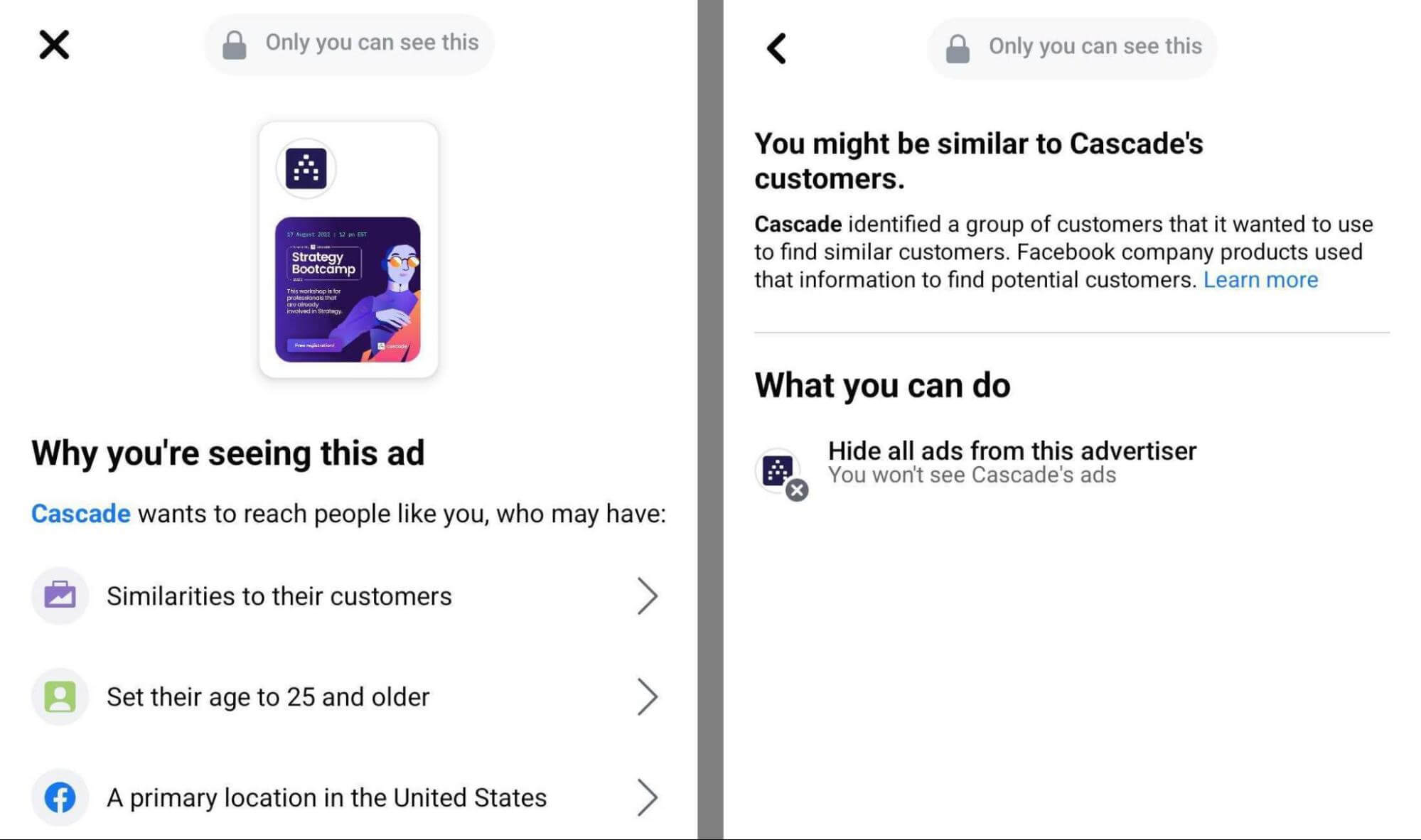
Browse the Meta Ads Library
Just because your news feed doesn’t display ads from specific competitors doesn’t mean they aren’t advertising. Fortunately, you can use the Meta Ad Library to do more in-depth research on any advertiser.
Open the ad library, select All Ads, and search for a keyword or a specific advertiser. Click on any search result to view all relevant active ads. To narrow your search, click on the filter in the upper-right corner. Using the Platform drop-down, select Facebook. You can also use the Media Type and Impressions by Date options to further narrow your search.
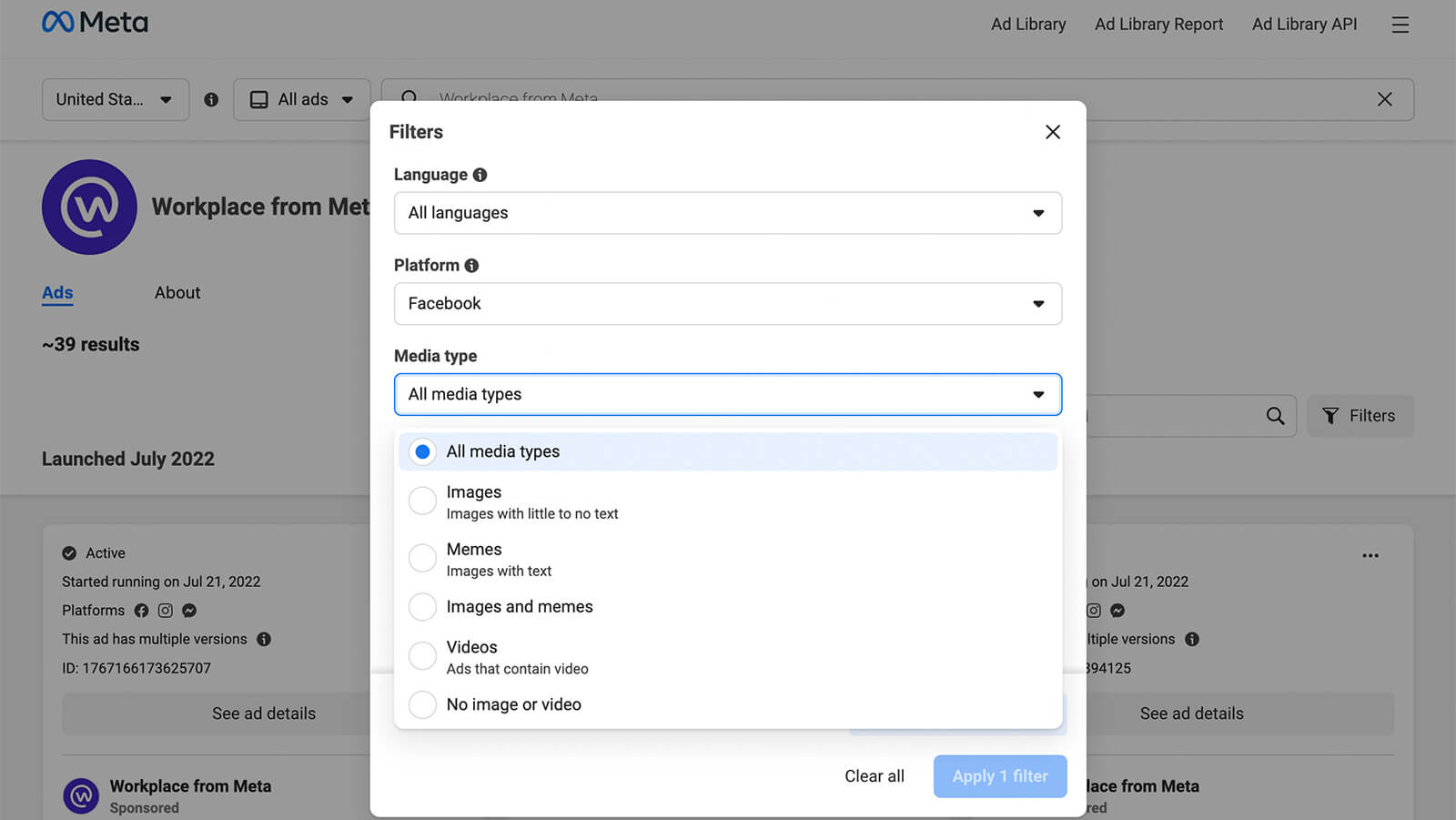
Then scroll through to see all of the advertiser’s active ads. Reading the ad copy and reviewing the creatives can help you understand the types of offers your competitors’ audiences prefer, the problems they need help with, and the goals they want to achieve.
To see the landing page linked to the ad, click on the call to action. To dig deeper into the ad, click the See Ad Details button. Here you can see if the ad has multiple versions, which can help you understand how your competitors are testing paid content on their audiences.
If the ad has a linked element like a lead form, you can also view those details. Scroll to the bottom of the page and click Additional Assets From This Ad. If you’re lucky, you’ll find enough data to understand the types of ad audience segments your competitors are building.
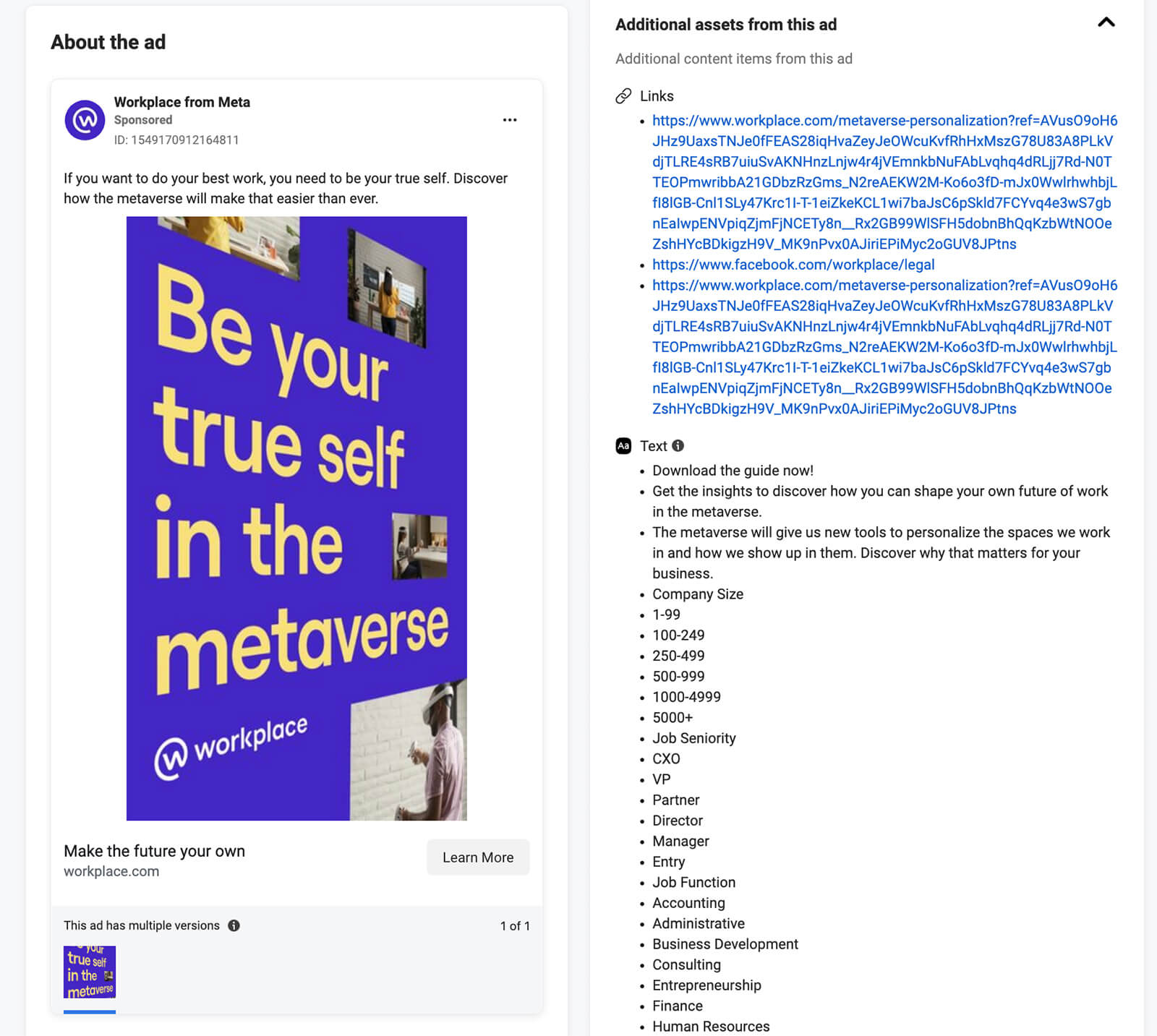
#3: 8 Ways to Use Targeting to Get in Front of Competitor Audiences on Facebook
Now you can apply your research to get in front of your competitors’ audiences. Using what you know about these audiences, you can create paid and organic content that resonates with them. With the right targeting setup, you can deliver ads to them, too. Let’s look at eight ways to build audiences you can use to target your Facebook ads.

Discover Proven Marketing Strategies and Tips
Want to go even deeper with your marketing? Check out the Social Media Marketing Podcast! Publishing weekly since 2012, the Social Media Marketing Podcast helps you navigate the constantly changing marketing jungle, with expert interviews from marketing pros.
But don’t let the name fool you. This show is about a lot more than just social media marketing. With over 600 episodes and millions of downloads each year, this show has been a trusted source for marketers for well over a decade.
Add Competitors to Saved Audiences
The most straightforward way to get in front of competitor audiences is to target Facebook users who have an interest in their pages. To use this targeting option, go to the ad set level of your Facebook ad campaign and scroll down to the Detailed Targeting section.
Click the Edit button and type a competitor into the search bar. In most cases, you’ll want to look for search results that are categorized as Interests. Hover over any potential match to make sure the targeting is a good fit. In the example below, choosing the highlighted option would help you reach people who like the Facebook Messenger page and others like it.
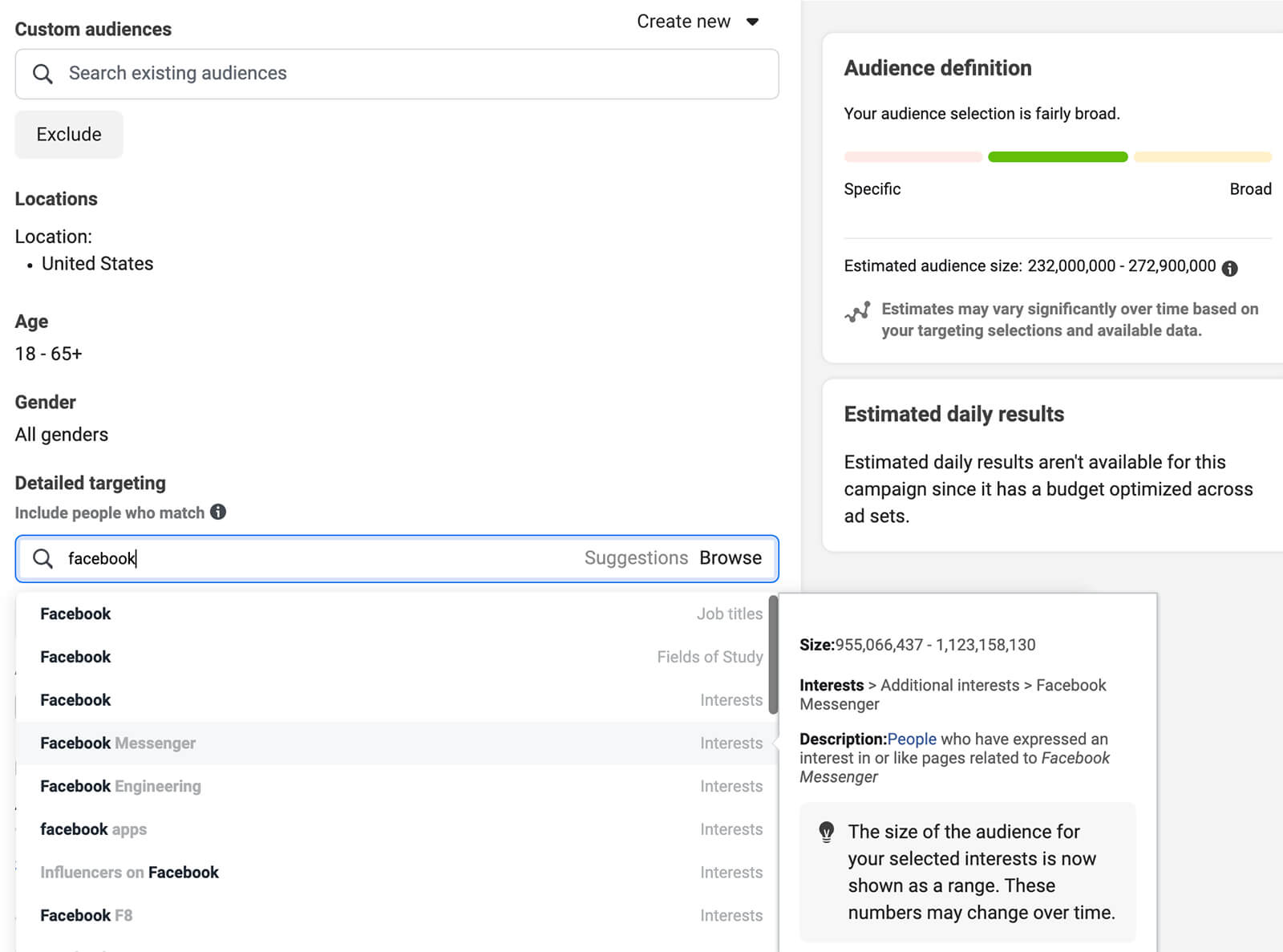
As you add competitor page targeting to your audience, keep an eye on the estimated size. Audiences that are overly large (over 100 million) may allow efficient delivery but they could be too broad. It’s a good idea to test a few ad groups with different audience targeting against each other to find the settings and size that work best for your purposes.
To get the most accurate audience size estimate possible, be sure to uncheck Advantage Detailed Targeting. Although this feature may allow more efficient ad delivery, it expands your targeting significantly. If you’re planning to test ad sets against each other, it’s important to remove this targeting option to avoid a lot of overlap.
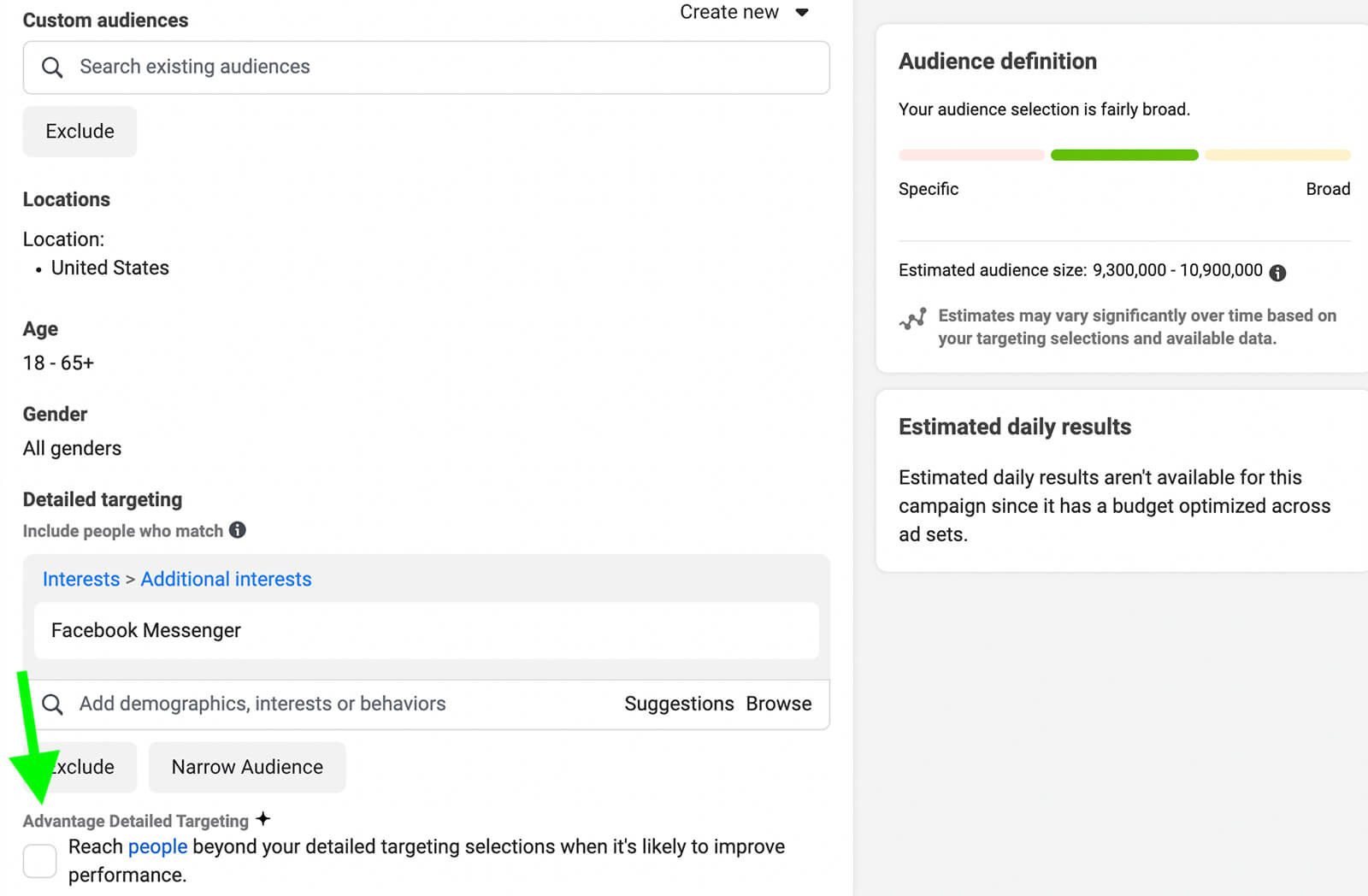
Target Fans of Competitors’ Top Influencers
Along with competitors, you can also target select influencers. Use the same workflow described above to add their top influencers to your ad group and build your audience. Note that many micro-influencers and even some mega-influencers may not be options for Facebook ad targeting. In early 2022, Meta removed many targeting options with smaller audiences.
If you find that the only available influencers have massive estimated audience sizes (10+ million), it’s helpful to narrow your targeting. After all, celebrity influencers are likely to have audiences with a diverse range of interests. That means some may fit your target audience and others may not. Consider combining influencer and interest targeting (see below) to ensure you’re reaching a well-defined audience and avoid wasting ad spend.
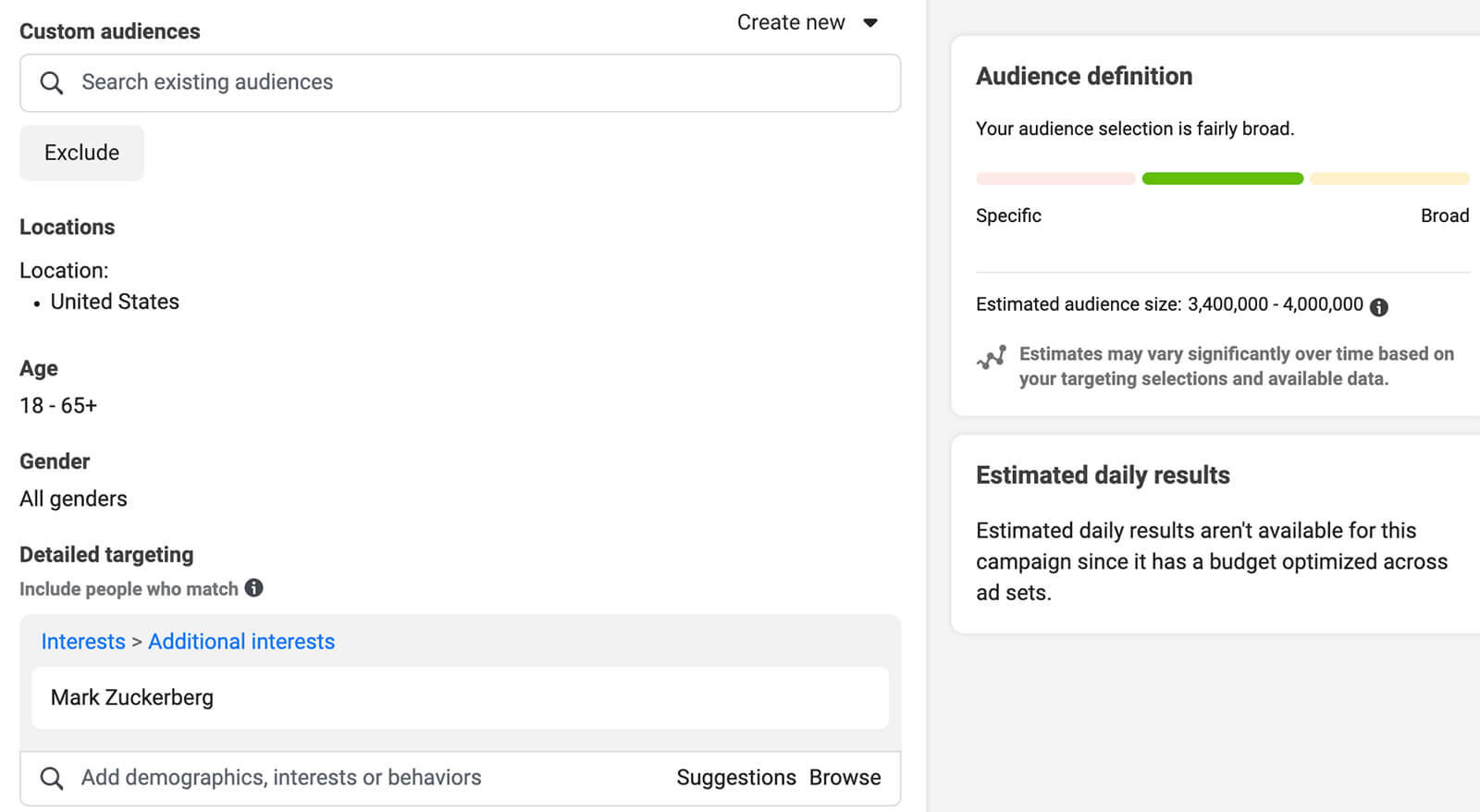
Repurpose Competitor Interest Targeting
Did you notice that many of the competitor ads in your feed used interest targeting? You can use the same workflow to build interest-based audience segments. To set up broader targeting, you can use the Browse function and add entire interest categories. But if you want to build a more defined audience, it’s helpful to search for specific interests.
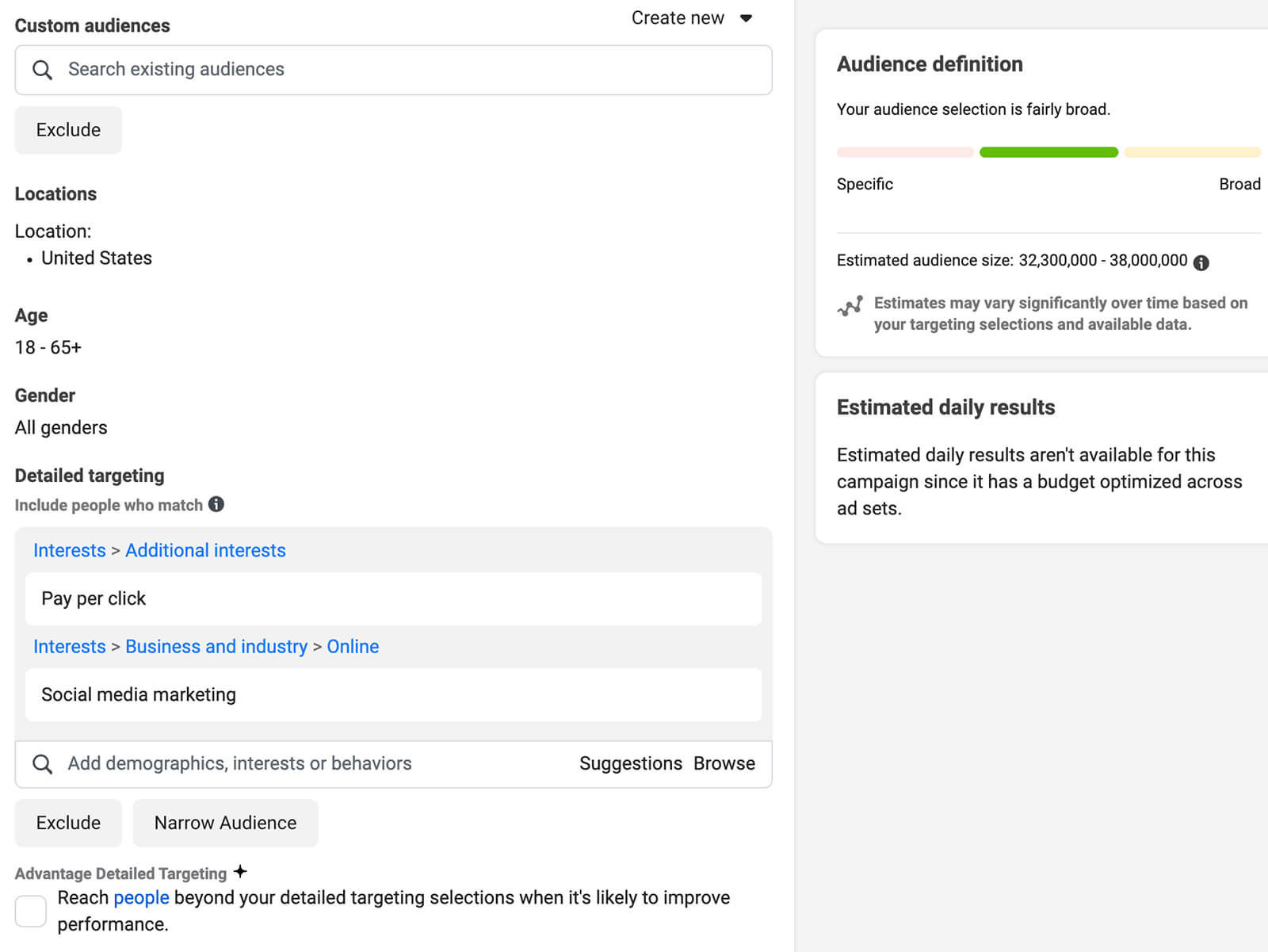
For best results, test interests with large audience sizes against each other to see what works best. For more niche interests, group similar ones together to build segments. You can use Facebook Ads’ built-in A/B testing feature to compare ad sets against each other.
As you identify high-performing segments, consider combining them to refine your audience targeting further. For example, combining interest and competitor page targeting can help you reach much more specific slices of their audiences.
Borrow Competitor Demographics
Based on your sales data and website analytics, you may think you’ve found the ideal demographic for your offer. But if you notice that other brands in your industry are using different demographics for their ads, it may be worth testing them.
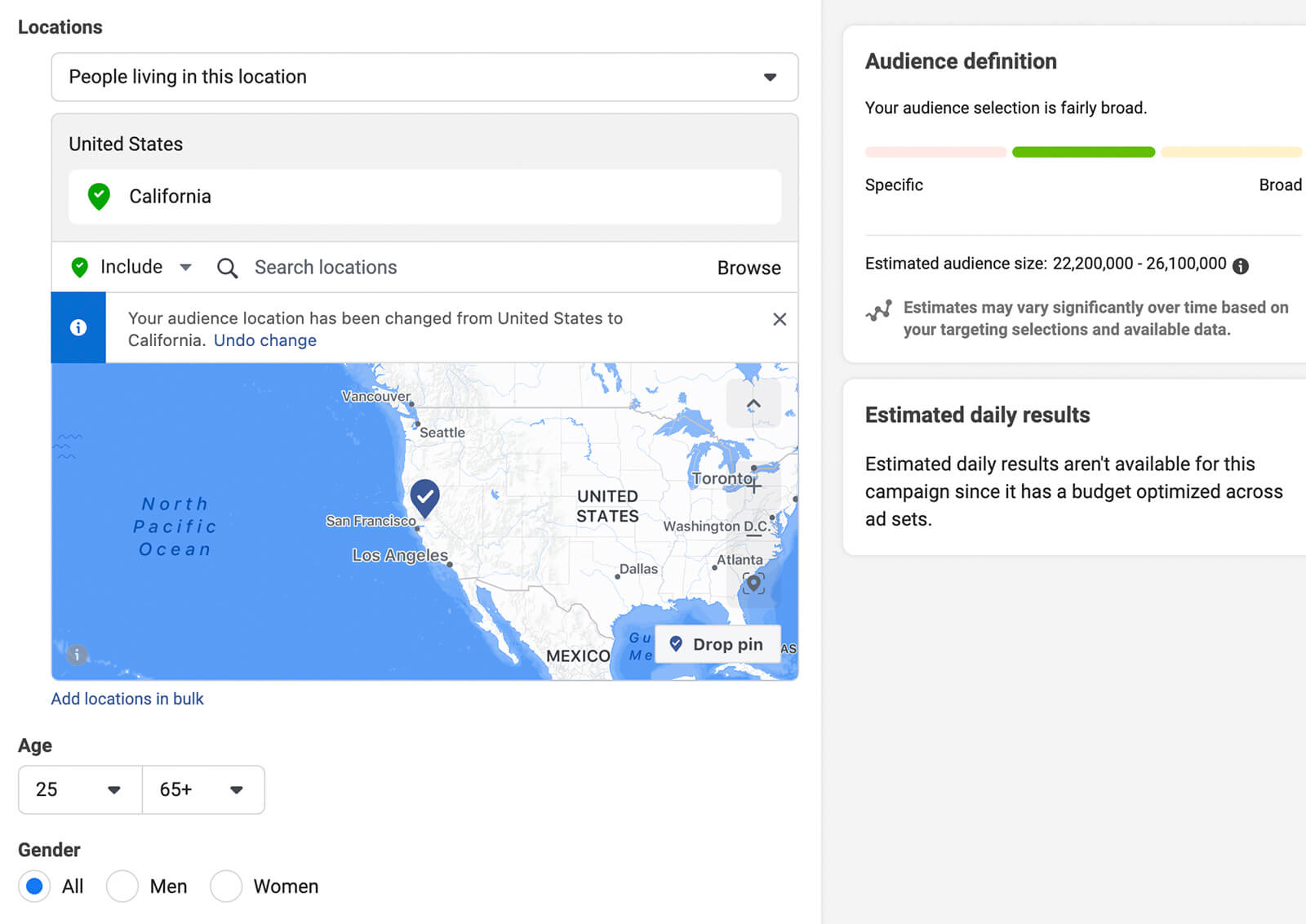
You can easily enter competitors’ age, gender, and location targeting at the ad set level. For broad targeting, you can limit your settings to demographics only and then rely on Meta to deliver your ads to the most viable audience. Or if you want more control, combine demographic with interest or page targeting.
Remarket Using Facebook Activity
Once your ads start to generate engagement and traffic, you can start using them to build remarketing audiences. If you’re building a Facebook ad funnel, then your top-of-funnel campaign might focus on generating in-app engagement. To leverage that engagement and remarket to your competitors’ audiences, create a new custom audience.
Then select the engagement type you want to target. For example, you can target people who engaged with your posts and ads during a certain timeframe. Meta defaults to retargeting anyone who engaged in the past 365 days. But you may want to narrow that time frame significantly to reach people who showed interest recently.
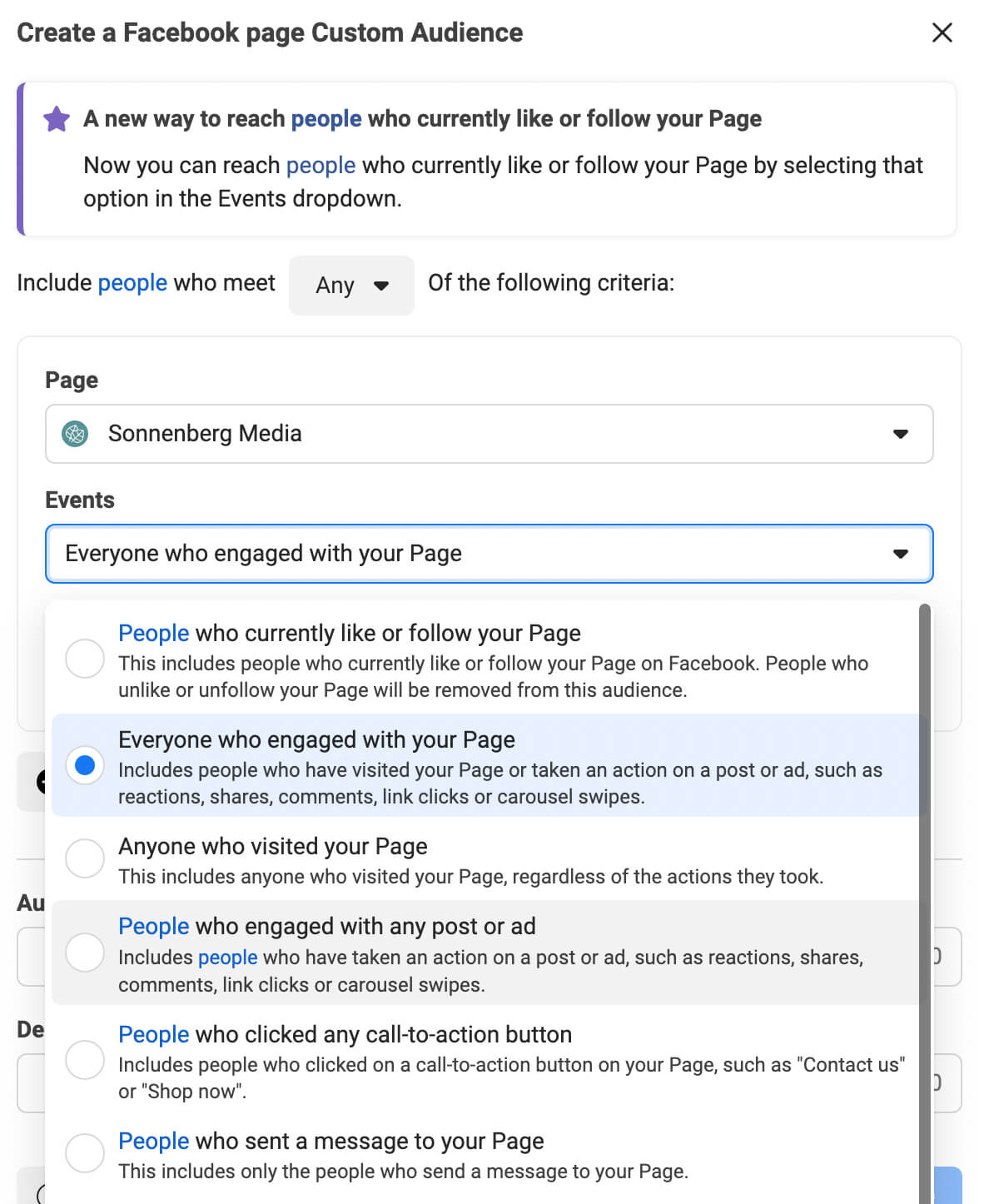
You can also target people who watched part or all of specific videos. If you want to lead your competitors’ audiences through a carefully designed funnel, retargeting video viewers is a great way to identify interested prospects and guide them toward a conversion.
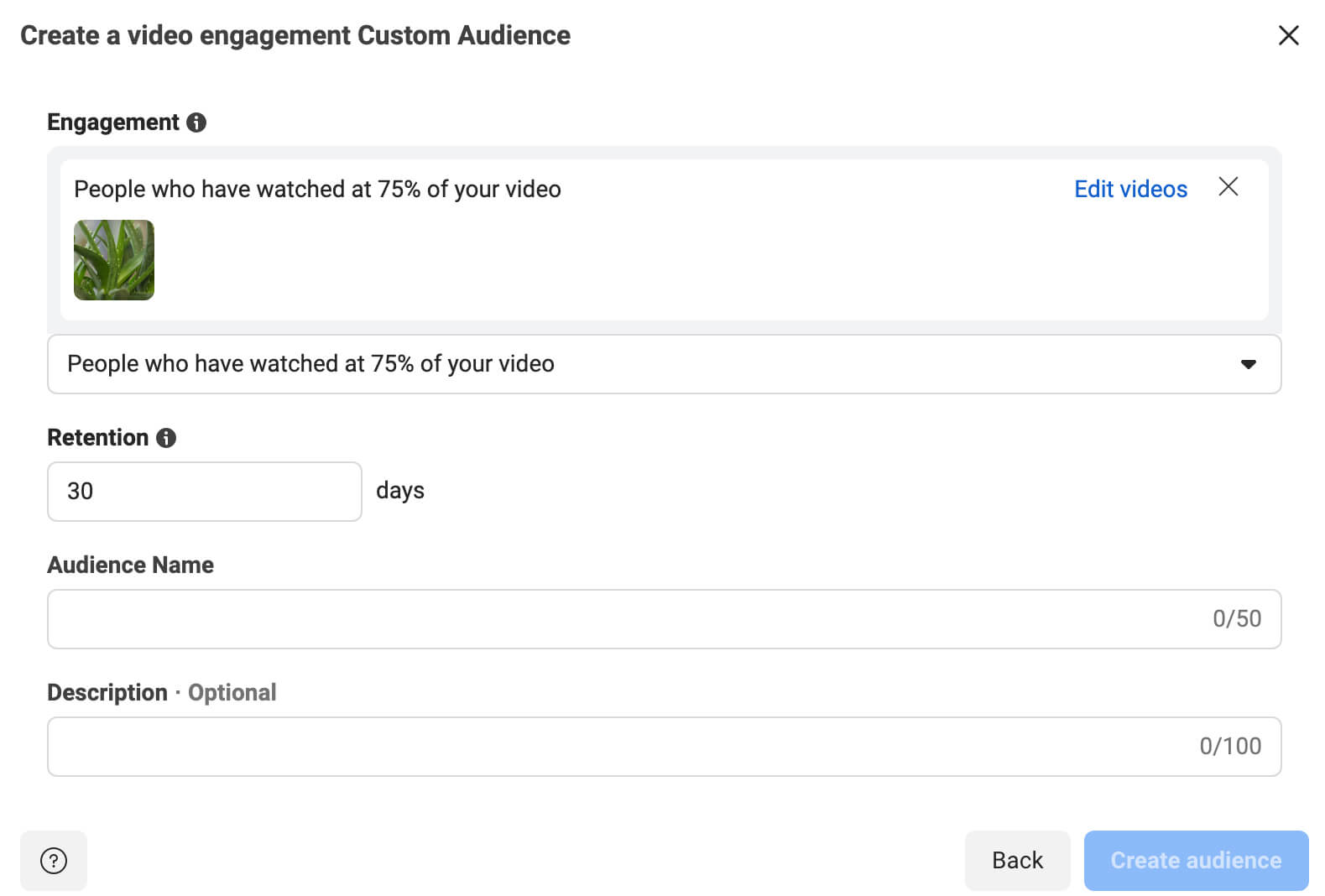
Upload Customer Segments
Does your Facebook advertising funnel involve getting prospects to sign up for your list? If a lot of your competitors’ customers have subscribed to your marketing, you can retarget them via a customer list upload.
If your list is on the smaller side, it’s a good idea to upload the full list. But if it includes a lot of different audience groups, it’s a better idea to segment it so you can create separate targeted lists.
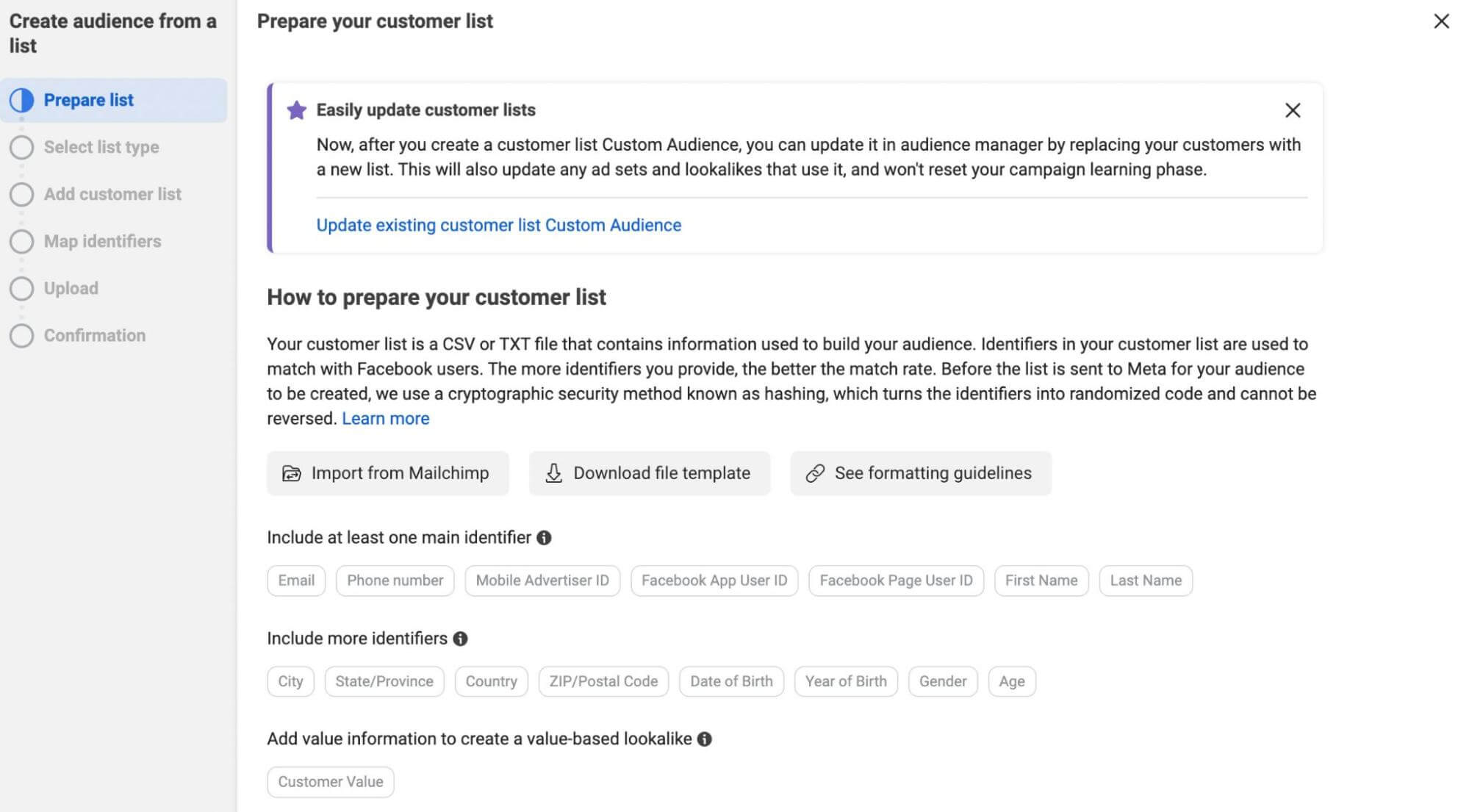
Create Custom Website Audiences
If your organic content or ads have driven competitor traffic to your company’s website, you can also retarget site visitors. Keep in mind that many advertisers have experienced below-average results with website-based audiences due to Meta’s recent privacy-related changes.
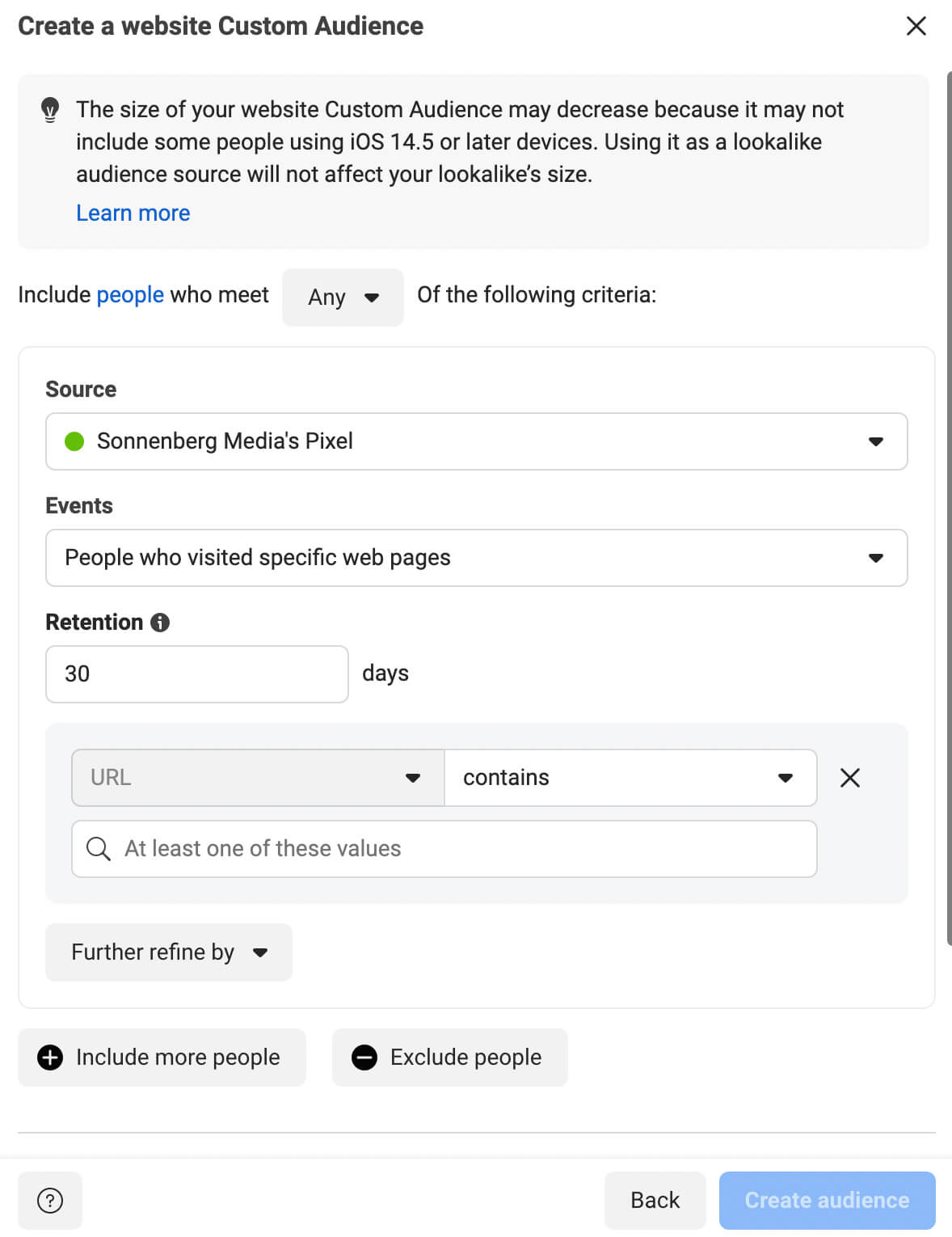
Before implementing any website campaign objectives or ad set audiences, make sure you’ve configured your Meta pixel and set up prioritized events. Then optimize your ad sets for one of your prioritized events for the most efficient ad delivery possible.
Build Lookalike Audiences
When one of your competitor-inspired audiences starts generating leads and conversions, think about targeting similar audiences. Facebook Ads’ lookalike targeting typically delivers the best results when you use value-based sources like pixels and product catalogs.
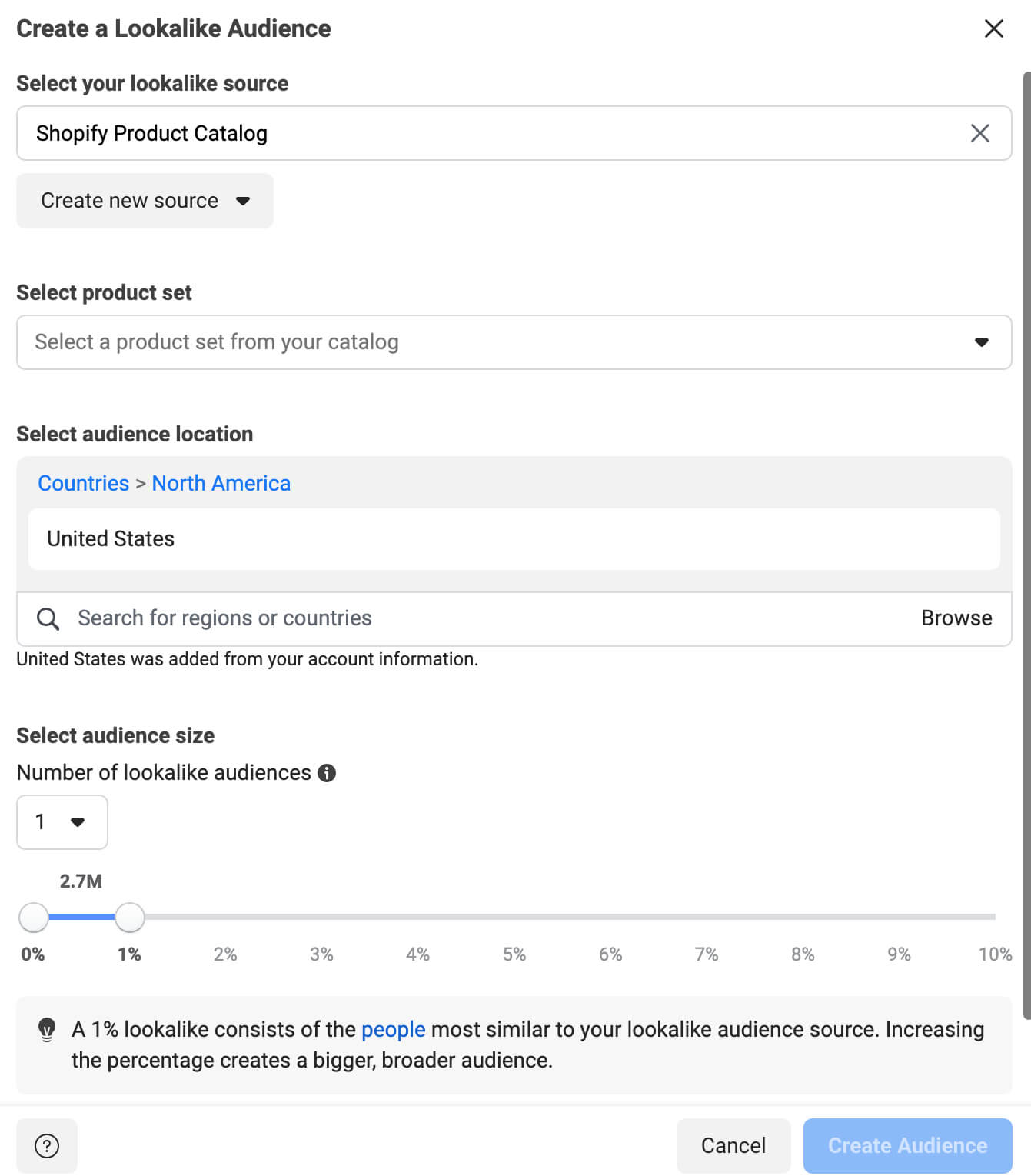
But you can also use Meta sources like Facebook page activity to seed your audience. Start small with a 1% lookalike. Then consider expanding to 2% or larger if the results are promising and once the initial lookalike audience has run its course.
Conclusion
Getting your content in front of competitor audiences can be remarkably helpful for expanding your customer base and adding new prospects to your funnel. With these tactics for researching organic and paid audiences, you can discover new ways to connect with your target audience and reach more of your ideal customers.
Stay Up-to-Date: Get New Marketing Articles Delivered to You!
Don't miss out on upcoming social media marketing insights and strategies! Sign up to receive notifications when we publish new articles on Social Media Examiner. Our expertly crafted content will help you stay ahead of the curve and drive results for your business. Click the link below to sign up now and receive our annual report!
Attention Agency Owners, Brand Marketers, and Consultants

Introducing the Marketing Agency Show–our newest podcast designed to explore the struggles of agency marketers.
Join show host and agency owner, Brooke Sellas, as she interviews agency marketers and digs deep into their biggest challenges. Explore topics like navigating rough economic times, leveraging AI, service diversification, client acquisition, and much more.
Just pull up your favorite podcast app, search for Marketing Agency Show and start listening. Or click the button below for more information.

